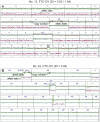Genome haploidisation with chromosome 7 retention in oncocytic follicular thyroid carcinoma
- PMID: 22675538
- PMCID: PMC3365880
- DOI: 10.1371/journal.pone.0038287
Genome haploidisation with chromosome 7 retention in oncocytic follicular thyroid carcinoma
Abstract
Background: Recurrent non-medullary thyroid carcinoma (NMTC) is a rare disease. We initially characterized 27 recurrent NMTC: 13 papillary thyroid cancers (PTC), 10 oncocytic follicular carcinomas (FTC-OV), and 4 non-oncocytic follicular carcinomas (FTC). A validation cohort composed of benign and malignant (both recurrent and non-recurrent) thyroid tumours was subsequently analysed (n = 20).
Methods: Data from genome-wide SNP arrays and flow cytometry were combined to determine the chromosomal dosage (allelic state) in these tumours, including mutation analysis of components of PIK3CA/AKT and MAPK pathways.
Results: All FTC-OVs showed a very distinct pattern of genomic alterations. Ten out of 10 FTC-OV cases showed near-haploidisation with or without subsequent genome endoreduplication. Near-haploidisation was seen in 5/10 as extensive chromosome-wide monosomy (allelic state [A]) with near-haploid DNA indices and retention of especially chromosome 7 (seen as a heterozygous allelic state [AB]). In the remaining 5/10 chromosomal allelic states AA with near diploid DNA indices were seen with allelic state AABB of chromosome 7, suggesting endoreduplication after preceding haploidisation. The latter was supported by the presence of both near-haploid and endoreduplicated tumour fractions in some of the cases. Results were confirmed using FISH analysis. Relatively to FTC-OV limited numbers of genomic alterations were identified in other types of recurrent NMTC studied, except for chromosome 22q which showed alterations in 6 of 13 PTCs. Only two HRAS, but no mutations of EGFR or BRAF were found in FTC-OV. The validation cohort showed two additional tumours with the distinct pattern of genomic alterations (both with oncocytic features and recurrent).
Conclusions: We demonstrate that recurrent FTC-OV is frequently characterised by genome-wide DNA haploidisation, heterozygous retention of chromosome 7, and endoreduplication of a near-haploid genome. Whether normal gene dosage on especially chromosome 7 (containing EGFR, BRAF, cMET) is crucial for FTC-OV tumour survival is an important topic for future research. MICROARRAYS: Data are made available at GEO (GSE31828).
Conflict of interest statement
Figures





References
-
- Ferlay J, Shin HR, Bray F, Forman D, Mathers C, et al. Estimates of worldwide burden of cancer in 2008: GLOBOCAN 2008. Int J Cancer. 2010;127:2893–2917. - PubMed
-
- Tallini G, Hsueh A, Liu S, Garcia-Rostan G, Speicher MR, et al. Frequent chromosomal DNA unbalance in thyroid oncocytic (Hurthle cell) neoplasms detected by comparative genomic hybridization. Lab Invest. 1999;79:547–555. - PubMed
-
- Frisk T, Kytola S, Wallin G, Zedenius J, Larsson C. Low frequency of numerical chromosomal aberrations in follicular thyroid tumors detected by comparative genomic hybridization. Genes Chromosomes Cancer. 1999;25:349–353. - PubMed
MeSH terms
Substances
Supplementary concepts
Associated data
- Actions
LinkOut - more resources
Full Text Sources
Medical
Molecular Biology Databases
Research Materials
Miscellaneous

